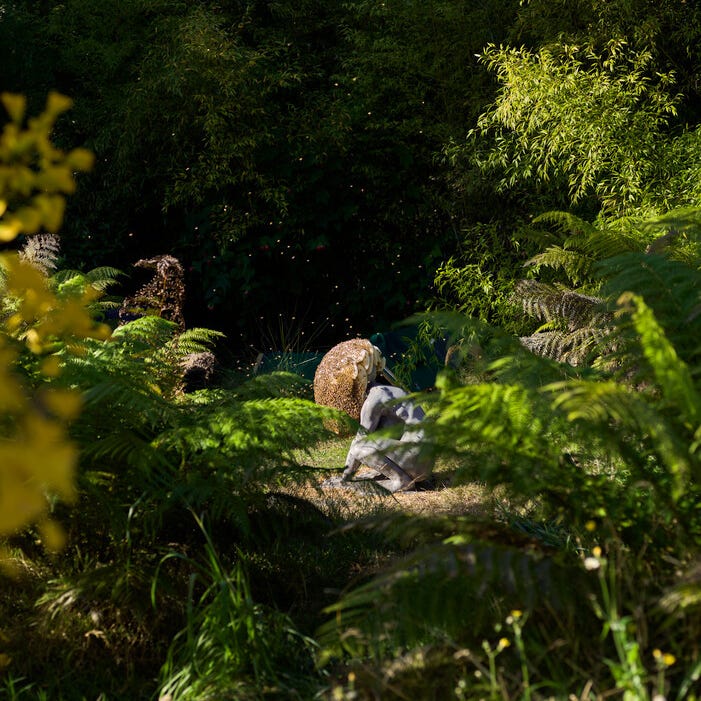Portrait of Clare Rojas at the opening of Clare’s Balls. Courtesy of the artist and Jessica Silverman, San Francisco
If it wasn’t for the candy-colored gumdrops that descend from the sky in Clare Rojas’s Walking in rainbow rain (2021), you might never notice the figure walking quietly through the stormy weather. Their raincoat blends in with the gray background, a hood pushed up over their head only slightly reveals the face behind it. Is it simply to keep them from getting soaked from the colored storm? Or is it to help their body further dissolve into the environment around them?
Rojas’s work is full of layers of meaning. In this painting, the rainbow raindrops allude both to human relationships with nature and, more prominently, to the history of the LGBTQ+ movement in San Francisco. The artwork prompts you to think about where you are — your distinct place in the world at any time — and the histories that make you want to shine in the sun or pull your hood down tighter from the rain.
Walking in rainbow rain is featured in About Place: Bay Area Artists from the Svane Gift, the second in a series highlighting contemporary Bay Area artists in the Fine Arts Museums of San Francisco’s collection. Here, Rojas tells us more about her piece, insights from her career, and what she loves about San Francisco and the de Young museum.
Clare Rojas, Walking in rainbow rain, 2021. Oil on linen canvas, 56 x 70 in. (142.2 x 177.8 cm). Fine Arts Museums of San Francisco, Museum purchase, a gift from The Svane Family Foundation, 2022.26.4 ©️ Clare Rojas. Courtesy of the artist and Jessica Silverman, San Francisco
Shaquille Heath: Your piece, Walking in rainbow rain, was recently acquired by the Fine Arts Museums of San Francisco. Can you talk me through its creation?
Clare Rojas: At the time, I was thinking a lot about how we unconsciously reflect and become a product of our environments. I was making a music video for one of my songs, Ghosts Are Not Angels. This painting was based on a still from that video. Painting Walking in rainbow rain felt like painting meditation.
SH: I see the artwork was created in 2021 — is this piece related to the pandemic? If so, how do you feel that time influenced the direction of your work?
CR: For me, the pandemic was socially mandatory uninterrupted time to paint without distraction.
SH: Are you the kind of artist who knows what you want to create before you approach the canvas, or do the ideas come best when you allow yourself to just create?
CR: It’s both. I have a well laid out plan and a sketch, and then I begin to paint. It never seems to go as planned, which is always exciting and scary.
SH: Your work has evolved throughout your career, and you’ve taken on a more abstract tone at times. What is your favorite thing about working in the abstract?
CR: I love watching the colors, the layers, and the textures take on the narrative, instead of the reverse. Abstraction is its own form of narration, with its own forms of emotional connection.
Detail from Walking in rainbow rain
SH: Do you have any advice for artists who want to change things up but are nervous to lose momentum?
CR: I think there is freedom in having nothing to lose. It can be a surprisingly fortunate place to be. I guess my advice would be to just keep working, and know that everything you do and experiment with will have value.
SH: As someone not originally from San Francisco, what do you think the city best offers for you in terms of inspiration?
CR: The landscape is so outrageously beautiful: the redwoods, mountains, and ocean. The fog is also its own San Francisco character.
SH: Do you remember when you first wanted to be an artist? And do you remember when you decided to actually be an artist, if those are different journeys?
CR: I think as a young child all I wanted to do was draw and paint. That was the only form of communication that worked for me. I’m not sure I knew what it meant to be an artist. I never thought being an artist was a choice. I also never thought not being an artist was a choice. I don’t think I can choose how my brain works.
Clare Rojas, See The Light, 2009. Color aquatint and sugarlift aquatint etching, 30 1/2 x 36 in. (77.5 cm x 91.4 cm). Fine Arts Museums of San Francisco, Museum purchase, Phyllis C. Wattis Fund for Major Accessions, 2015.37.399 ©️ Clare Rojas. Courtesy of the artist and Jessica Silverman, San Francisco
SH: I read that you took some time away from your art many years ago and spent some time writing. I’m wondering how that space and time away evolved or changed your practice?
CR: It made me realize how hard it is for me to articulate my story, my narrative, with words versus with images. I realized I can’t redefine or make up new words, but I can paint new meanings and new definitions.
SH: What other art forms influence your practice?
CR: Music, literature, cooking, gardening, sculpture, film . . . all of it. I love all of it.
SH: Do you have a favorite painting or gallery to visit at the de Young or Legion of Honor?
CR: The de Young is wonderful. The historic sections, however, are at the top of my list. One piece I love is the Dalilah sculpture (1877) by William Wetmore Story.
This conversation has been edited for length and clarity.









